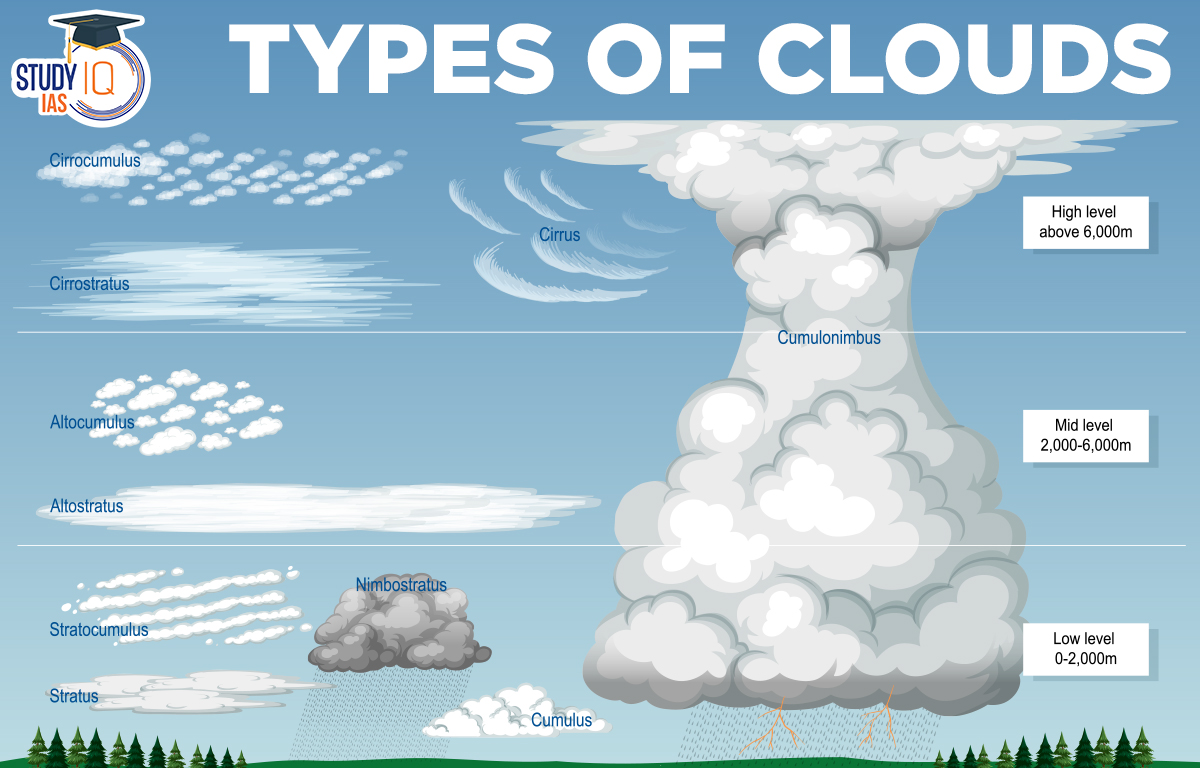Table of Contents
What is a Cloud?
A cloud is made up of tiny ice crystals and water droplets that float in the air. They look big and fluffy to our eyes. There are many types of clouds, and they differ in size, shape, and color. Clouds play an important role in our climate helping to cool the Earth by reflecting sunlight back into space. Clouds form when the air is full of water vapor. Warm air can hold more water vapor than cold air. When warm, moist air cools down, the water vapor turns into tiny droplets or ice crystals, making clouds. If the air cools enough, these droplets can grow larger and fall to the ground as rain, snow, sleet, or hail.
Read about: Monsoon in India
Cloud Formation
- Clouds form when water vapour in the air condenses into water droplets or ice crystals.
- Water vapour is always present in the air as tiny gas particles.
- The air also contains tiny particles called aerosols, like dust and salt. Water vapour and aerosols often collide.
- When the air cools, water vapour sticks to aerosols, causing condensation.
- These aerosol particles attract more water droplets, forming clouds.
Clouds form when the air can not hold any more water vapour. This happens in two ways:
- Increase in Water Vapour: More water enters the air through evaporation.
- Cooling of Air: The air cools to its dew point, where condensation starts because it can’t hold more water.
- Warm air can hold more water vapour.
- As air rises, it cools and loses its ability to hold water vapour, leading to condensation.
- Clouds form at the height where the dew point is reached.
Types of Clouds
Clouds have a big impact on the weather and climate of our planet. They form when water in the sky condenses into tiny droplets or ice crystals, making them visible.
Water can come from different places or evaporate from the ground. Even though water vapor is invisible, it is always in the air. When a part of the atmosphere cools down enough, the water vapor turns into liquid, creating clouds. Water tends to condense around things like salt, ice, or dust in the air.
Importance of Clouds
They are essential during rain or snow. Clouds reflect heat back to the earth during the night, keeping it warm. By blocking the sun’s rays during the day, clouds help to keep it cooler outside. Understanding clouds aids in comprehending weather and climate.
Clouds Classification based on Altitude of Clouds
Based on how they form at various heights, clouds are categorised. In the polar, tropical, etc., regions, Different Types of clouds form at different altitudes. The classification of clouds and related cloud types are provided in the table below.
| Types of Clouds | Altitude | Characteristics |
| High Clouds | High clouds are found above 6000 metres or 20,000 feet from the surface of the Earth |
|
| Middle Clouds | Middle clouds are known to form between 2000 metres to 6000 m or 6500 feet from the surface of the Earth.. |
|
| Low Clouds | Low clouds occur at altitudes below 2000 metres or 6500 feet from the surface of the Earth |
|
| Great Vertical Extent Clouds | Great Vertical Extent Clouds are found to occur at very high altitudes |
|
1. High-Level Clouds
Polar Regions – they form at altitudes of 3000 m (10,000 ft) to 7600 m (25,000 ft).
Temperate Regions – they form at altitudes of 5000 m (16,500 ft) to 12,200 m (40,000 ft).
Tropical Regions – they form at altitudes of 6,100 m (20,000 ft) to 18,300 m (60,000 ft).
2. Mid-Level Clouds
Non-vertical clouds in the middle level are prefixed by the alto. At any latitude, these clouds are formed as low as 2000 m (6500 ft) above the surface. These clouds can be formed as high as 4,000 m (13,000 ft) near the poles These clouds are formed at an altitude of 7,600 m (25,000 ft) in the tropical region.
3. Low-level Clouds
These clouds are formed near the surface up to 2000 m (6500 ft). These types of clouds have no prefixes.
4. Vertical Clouds
These clouds cover the entire atmosphere, from the lower to the higher altitudes. The strong convectional circulation that holds and propels the cloud moisture further upward causes them to form through thermal convection or frontal lifting. The Cumulonimbus cloud is an illustration of a vertical cloud.
5. Foggy Clouds
Stratus cloud layer over or close to the ground. These develop near the earth. Sometimes they reduce visibility to the point where it is difficult to see farther than 60 feet.
Read about: Climate of India
Different Types of Clouds
According to their altitude, stretch, density, and transparency or opaqueness clouds are classified into the following types which are given below.
1. Cirrus Clouds
Cirrus clouds are thin clouds that look like narrow bands or white patches. They are made of ice crystals, and how spaced out these crystals are affects how clear they appear. Usually, cirrus clouds do not block much sunlight, but if they are thick, they can dim the sun’s light. These clouds often appear bright yellow or red at sunrise and sunset. They start glowing earlier and stay visible longer than other clouds, turning gray after the sun sets.
2. Cirrostratus
Cirrostratus clouds are thin, whitish clouds that look smooth or sometimes fibrous, like hair. They cover the whole sky in a large sheet. A important feature of cirrostratus clouds is that they can create a halo around the sun or moon. This makes them different from similar-looking thin stratus clouds, which don’t usually produce a halo effect.
3. Cirrocumulus
A thin layer of clouds that is completely white is called a cloud sheet or patch. These clouds are made of very tiny particles that look like evenly spaced grains or ripples.
4. Cumulus Clouds
Cumulus clouds usually form between 4,000 and 7,000 meters above sea level. They look like cotton wool and are scattered in patches across the sky. Their bottoms are flat. These clouds are often thick and have clear edges, rising up like mounds, domes, or towers that can look like cauliflower. The sunny parts of these clouds are bright white, while the bases are darker and flat.
5. Stratus Clouds
Stratus clouds mean it will be a cool, cloudy day. They usually look like a gray blanket in the sky. If they are thick enough, they can bring light rain, ice crystals, or snow. When the sun shines through these clouds, you can see its shape clearly. As the stratus clouds break apart, you might see blue sky peeking through.
6. Altostratus
Altostratus clouds are sheets or layers of gray or blue clouds that cover the sky, either completely or partially. They are thin enough that you can often see the sun through them, like looking through frosted glass. When altostratus clouds are present, you usually can not see halos around the sun or shadows on the ground.
7. Nimbostratus
The persistent cloud of rain. This is a dark grey cloud layer that is diffused by rain or snow that is falling. It is caused by thickening Altostratus. It is consistently thick enough to block out the sun. As the downpour continues, the cloud base descends into the low level of clouds.
8. Nimbus
Nimbus clouds usually form at lower altitudes and are often black or dark gray. They block sunlight and are associated with storms and heavy rain.
9. Cumulonimbus
A thunderstorm cloud, called a cumulonimbus cloud, looks like a huge, tall mountain. The top is often flat, like an anvil or a big puff. Below it, you can see rough, jagged clouds, and the base of the cloud is usually dark. These clouds can produce hail and even tornadoes.
10. Stratocumulus
White or gray clouds often have black patterns that look like a honeycomb, along with round shapes or rolls. They are usually not fibrous, except for virga, and they can mix together or stay separate.
11. Altocumulus
White and gray clouds often have flat plates, round shapes, or rolled forms. These clouds can be spread out or look a bit fibrous. When a thin, semi-transparent part of altocumulus clouds moves in front of the sun or moon, you can see a corona. This is a colored ring that appears close to the sun or moon, with red on the outside and blue on the inside.


 Desert Climate, Distribution, Climatic C...
Desert Climate, Distribution, Climatic C...
 Deserts of India Map, Features of Thar D...
Deserts of India Map, Features of Thar D...
 Indus Valley Civilization, History, Phas...
Indus Valley Civilization, History, Phas...





















